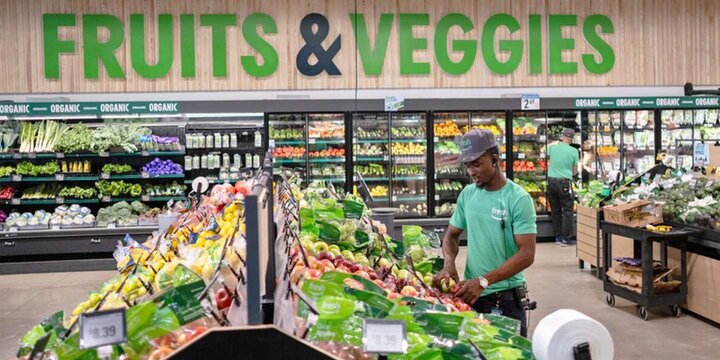Growing the Grocery Empire: Tech-Driven Solutions for a Better Shopping Experience

Amazon’s foray into the grocery industry has been marked by constant innovation, technological integration, and an ever-expanding footprint in both physical stores and online platforms. With the launch of Amazon Fresh, Whole Foods Market, and various third-party partnerships, the tech giant has become a formidable player in the grocery retail sector. Through these ventures, Amazon has demonstrated its ability to seamlessly integrate cutting-edge technology to improve the customer experience, streamline operations, and drive convenience for millions of shoppers worldwide.
Amazon Fresh, which debuted in 2020, quickly established itself as a key player in the grocery market. The grocery store format merges the convenience of online shopping with a brick-and-mortar experience. One of the standout features of Amazon Fresh is its Dash Cart, a smart shopping cart that automatically tracks items as they’re placed inside, allowing customers to skip traditional checkout lines. In 2024, Amazon expanded the use of Dash Carts to all U.S. Amazon Fresh stores and select third-party grocery stores.
Additionally, Amazon Fresh integrates Amazon One, a palm-based payment system, adding another layer of convenience for shoppers. As a result, Amazon is creating a seamless grocery shopping experience that blends advanced technology with consumer convenience, both online and offline. According to Claire Peters, the worldwide VP of Amazon Fresh, “Increasing our weekly deals across thousands of items and expanding the reach of Prime savings at Amazon Fresh is just one way that we’re continuing to invest in competitive pricing and savings for all of our customers – both in-store and online.”
Amazon’s e-commerce strength has always been a differentiator, and the company’s grocery division has capitalized on this advantage. In 2024, Amazon expanded its same-day two-hour grocery delivery service through partnerships with local and regional grocery chains like Lucky Supermarkets in the San Francisco Bay Area. This expansion provides Amazon Fresh customers with broader access to groceries and household essentials, further cementing its omnichannel approach. The partnerships allow Amazon to extend its reach beyond its proprietary stores, offering third-party grocery products delivered via the Amazon platform.
The Amazon Fresh online storefront is designed to replicate the physical grocery experience digitally. The site includes intuitive shopping zones that organize products by theme, such as weekly deals, seasonal favorites, and aisle-by-aisle navigation. This customer-first design enhances the online grocery shopping journey by mimicking the familiarity of in-store browsing.
Moreover, Amazon’s grocery delivery subscription plan, available for Prime members, offers unlimited grocery deliveries from Amazon Fresh, Whole Foods Market, and other local grocers for a fixed monthly or annual fee. Prime members receive free same-day delivery for orders over $35 and exclusive Prime Savings, allowing them to save on a rotating selection of grocery items.
We’re constantly innovating to make the grocery shopping experience seamless, fast, and convenient, whether customers are shopping in-store or online.

Expanding E-Commerce and Omnichannel Solutions
Revolutionizing the Grocery Experience with Amazon Fresh
Amazon’s decision to scale back its cashierless checkout systems at Amazon Fresh stores in 2024 reflects its willingness to listen to customer feedback and pivot accordingly. Initially launched as a hallmark of Amazon’s physical grocery stores, the Just Walk Out technology has now been removed from Fresh stores in favor of Dash Carts and more traditional checkout methods. This change is driven by customer preferences, with many shoppers favoring easy access to deals and the ability to view their receipts as they shop.
Amazon continues to push boundaries with its in-store technology, and its decision to recalibrate reflects its agile approach to innovation. As Carly Golden, an Amazon spokesperson, remarked, “We’ve invested a lot of time redesigning a number of our Amazon Fresh stores over the last year, offering a better overall shopping experience with more value, convenience, and selection.”
Amazon’s brick-and-mortar presence continues to grow alongside its digital operations. The company opened several new Amazon Fresh locations in 2024, including stores in Roseville, California, and Tinley Park, Illinois, bringing its total number of Amazon Fresh locations to 49 across eight states. These stores are equipped with omnichannel features such as fast grocery delivery and pickup options, creating a hybrid shopping experience for consumers who want the convenience of online shopping with the immediacy of in-store pickup.
Whole Foods Market, acquired by Amazon in 2017, also plays a significant role in Amazon’s grocery strategy. Prime members can enjoy exclusive deals at Whole Foods, with Amazon offering free two-hour delivery for eligible orders from Whole Foods locations. The combination of Whole Foods’ high-quality products and Amazon’s logistical prowess has allowed the company to cater to a broad spectrum of grocery shoppers.
Integration of Advanced Technology for In-Store and Online Shopping
Expanding Physical Footprint: Amazon Fresh and Whole Foods

Beyond its proprietary stores, Amazon has expanded its reach through third-party grocery partnerships. In 2024, Amazon began offering same-day delivery from Lucky Supermarkets in California, marking another step in its broader effort to diversify its grocery offerings(Amazon).
Amazon has also partnered with grocery retailers such as Metropolitan Market in Seattle, as well as Save Mart and Bristol Farms, providing customers with access to a wider variety of grocery products. This strategy allows Amazon to serve a wider geographic area while continuing to expand its grocery ecosystem.
Amazon has also ventured into the retail media space with the integration of advertisements within its grocery platforms. The company’s robust data analytics and consumer insights allow it to offer targeted advertising solutions to third-party brands, giving advertisers a direct connection to consumers through Amazon Fresh and Whole Foods Market.
Amazon’s leadership, under CEO Andy Jassy, has maintained a clear focus on grocery as a critical component of its long-term strategy. Jassy has emphasized the company’s commitment to leveraging its vast technological infrastructure to offer customers better value, selection, and convenience. “We’re constantly innovating to make the grocery shopping experience seamless, fast, and convenient, whether customers are shopping in-store or online,” Jassy remarked during a recent company event.
Amazon’s grocery division has grown into a formidable player in both physical and digital retail. By blending advanced technology, omnichannel strategies, and customer-centric solutions, Amazon continues to redefine how consumers shop for groceries. With ongoing expansion into new markets, an evolving partnership ecosystem, and a clear commitment to innovation, Amazon is well-positioned to maintain its leadership in the grocery industry for years to come.



